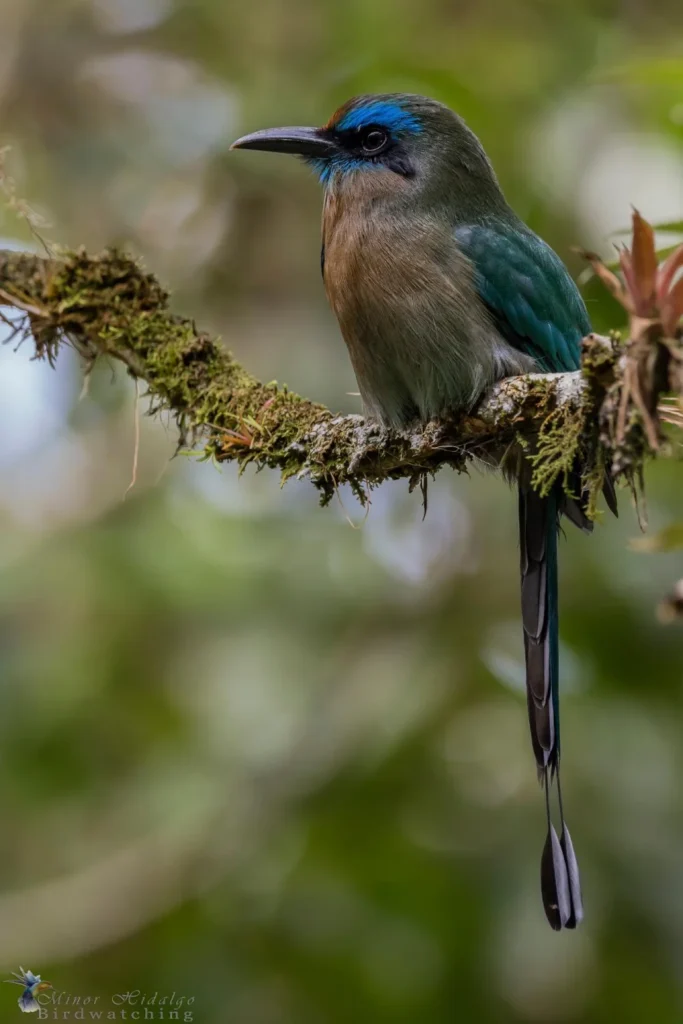Keel-billed Motmot
The Keel-billed Motmot is a medium-sized, colorful bird found in humid lowland forests from southern Mexico to northern Colombia, distinguished by its massive keel-shaped bill, green and rufous plumage, and characteristic racket-tipped tail that it swings like a pendulum while perched.

Electron carinatum
Scientific Name
Momotidae (Motmots)
Family
Coraciiformes
Order
Range and Habitat of Keel-billed Motmot
Geographic Range
The Keel-billed Motmot ranges from southeastern Mexico (including Veracruz, Oaxaca, and Chiapas) through Central America including Belize, Guatemala, Honduras, Nicaragua, Costa Rica, and Panama, extending into northwestern Colombia and western Ecuador.
Migratory Patterns
This is a non-migratory resident species with no documented seasonal movements.
Preferred Habitat
The Keel-billed Motmot inhabits primary humid lowland and foothill forests, mature secondary forest, and forest edges near streams. It shows a preference for ravines with dense canopy cover.
Altitude Range
Most common 50-750 m, occasionally to 1,200 m
Costa Rica Habitat
It can be found in the provinces of Guanacaste (limited distribution), Alajuela, Heredia, Limón, eastern Cartago, and northern Puntarenas. Notable protected areas where it occurs include La Selva Biological Station, Braulio Carrillo National Park, Tortuguero National Park, Rara Avis Reserve, Barbilla National Park, Hitoy-Cerere Biological Reserve, and Carara National Park.
Conservation Status
Vulnerable
Conservation Status
Population Status
Global population estimated at 20,000-50,000 individuals
Deforestation and habitat fragmentation, Loss of nesting sites from erosion control
Conservation efforts
Protected in several Costa Rican national parks, listed as priority species for conservation
Primary Threats
Deforestation and habitat fragmentation, Loss of nesting sites from erosion control
Keel-billed Motmot Identification
How to Identify the Species
Rarity Level:
UncommonBest Viewing Times:
Early Morning (Dawn - 8 AM), Afternoon (2 PM - 5 PM)
Size
Length: 32-38 cm; Weight: 55-75 g (males average 65 g, females 63 g)
Plumage
This motmot displays overall green plumage with a bluish-green sheen on the upperparts. The forehead and forecrown are distinctively rufous, contrasting with a black mask that extends through the eyes to the ear coverts. The blue-green tail features the characteristic racket tips that motmots are famous for, and when the wings are spread, blue flight feathers become visible.
Distinctive Features
The most notable feature is the broad, keeled bill measuring 25-30 mm, which is flattened with a raised central ridge, giving the species its name. The bill is black above and horn-colored below.
Sexual Dimorphism
Minimal - males average slightly larger with marginally longer tail streamers, but differences not reliable for field identification.
Diet and Feeding Behavior
Primary Diet
- Large insects: beetles, cicadas, grasshoppers, katydids, walking sticks; spiders; frogs, lizards (anoles, geckos); occasionally small snakes
Foraging Techniques
- Sit-and-wait predator from low to middle perches
Feeding Times
- Most active early morning (5:30-9:00) and late afternoon (15:00-17:30)
Behavior Patterns
Keel-billed Motmot
Social Structure
Keel-billed Motmots are usually observed solitary or in pairs, maintaining long-term pair bonds. Family groups can be seen during the breeding season, and individuals occasionally join mixed-species foraging flocks.
Song and Vocalization
The primary call is a deep, hollow “hoop-hoop” or “whoop-whoop,” notably lower-pitched than vocalizations of other motmot species. The dawn song consists of a series of “kawk-kawk-kawk” notes. Pairs maintain contact with soft “wuk” or “huk” calls, while a sharp “kyuk!” serves as an alarm call when threatened.
Courtship and Mating Ritual
Courtship behaviors include mutual tail-swinging displays, courtship feeding, synchronized calling between pairs, and bill-touching ceremonies that strengthen pair bonds.
Territoriality
Pairs maintain year-round territories ranging from 3-8 hectares in size, depending on habitat quality.
Birdwatching Tips
Best Locations for Spotting Keel-billed Motmot
Prime locations include La Selva Biological Station (particularly the CES and CEN trails), Braulio Carrillo National Park (Quebrada González sector), Rara Avis Reserve, Selva Verde Lodge trails, Cope Arte trail near Guápiles, Tirimbina Biological Reserve, Veragua Rainforest, and Hitoy-Cerere Biological Reserve.

Best Time of the Year
While present year-round, the species is most active and vocal from March-May during the breeding season.
Common Behavior
Look for birds perching quietly for long periods on horizontal branches, often displaying their characteristic tail-swinging motion. Check shaded areas 2-5 meters above ground, particularly near streams or ravines. Listen for deep hooting calls at dawn. The species may respond to playback of calls and is generally more easily seen than other forest motmots.
Recommended Gear
Essential equipment includes 8×42 binoculars for forest viewing, a flashlight for checking potential nest burrows, an audio playback device (to be used sparingly), a camera with good low-light performance.
Breeding and Nesting Behavior
Breeding Season
March-May, peak April (dry to early wet season)
Nesting Sites
Burrow excavated in earthen bank or hillside, tunnel 1-3 m long, angled upward for drainage
Clutch Size
2-4 eggs (usually 3)
Incubation Period
21-22 days
Parental Care
Both parents incubate and feed young. Chicks fledge at 29-32 days. Post-fledging care continues for 4-6 weeks.
Did You Know?
Interesting Behaviors
Pendulum tail-swinging may communicate emotional state
Cultural Significance
Name “pájaro bobo” (foolish bird) comes from its habit of sitting still and allowing close approach
Surprising Traits
They can hover briefly like a hummingbird when necessary
How do I identify this bird?
Medium-sized green bird with distinctive broad, flattened bill with raised ridge (keel). Look for rufous forehead, black mask, blue throat, and long tail with racket tips. The broad bill distinguishes it from other motmots.
Where is the best place to see it in Costa Rica?
La Selva Biological Station is most reliable, especially along forest trails early morning. Braulio Carrillo National Park’s Quebrada González sector and Selva Verde Lodge area also offer good opportunities. Listen for deep hooting calls.
Is it endangered?
Listed as Vulnerable due to habitat loss and fragmentation. Population declining throughout range. Requires primary or mature secondary forest, making it sensitive to deforestation.